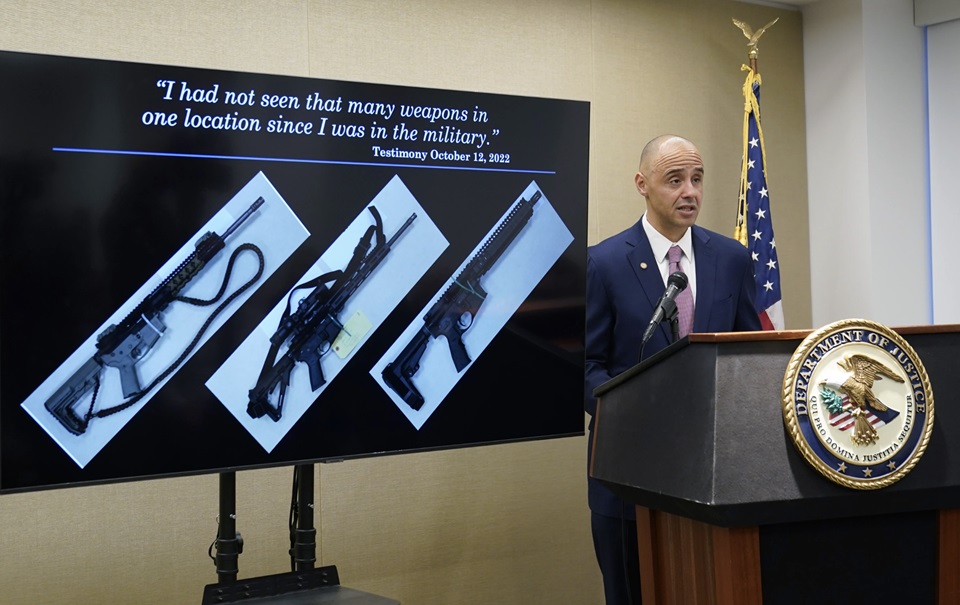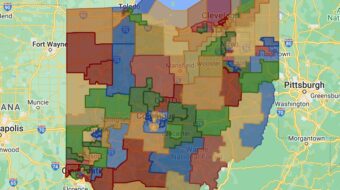
WASHINGTON (AP)—Members of far-right extremist groups. Former police officers. An Olympic gold medalist swimmer. And active-duty U.S. Marines.
They are among the hundreds of people who have been convicted in the massive prosecution of the Jan 6, 2021, insurrection in the three years since the stunned nation watched the U.S. Capitol attack unfold on live TV.
Washington’s federal courthouse remains flooded with trials, guilty plea hearings, and sentencings stemming from what has become the largest criminal investigation in American history. And the hunt for suspects is far from over.
“We cannot replace votes and deliberation with violence and intimidation,” Matthew Graves, the U.S. attorney for the District of Columbia, told reporters on Thursday.
Authorities are still working to identify more than 80 people wanted for acts of violence at the Capitol and to find out who placed pipe bombs outside the Republican and Democratic National Committees’ offices the day before the Capitol attack. And they continue to regularly make new arrests, even as some Jan. 6 defendants are being released from prison after completing their sentences.
The cases are playing out at the same courthouse where Donald Trump is scheduled to stand trial in March in the case accusing the former president of conspiring to overturn his 2020 election loss in the run-up to the Capitol attack.
Here’s a look at where the cases against the Jan. 6 defendants stand:

By the numbers
More than 1,230 people have been charged with federal crimes in the riot, ranging from misdemeanor offenses like trespassing to felonies like assaulting police officers and seditious conspiracy. Roughly 730 people have pleaded guilty to charges, while another roughly 170 have been convicted of at least one charge at a trial decided by a judge or a jury, according to an Associated Press database.
Only two defendants have been acquitted of all charges, and those were trials decided by a judge rather than a jury.
About 750 people have been sentenced, with almost two-thirds receiving some time behind bars. Prison sentences have ranged from a few days of intermittent confinement to 22 years in prison. The longest sentence was handed down to Enrique Tarrio, the former Proud Boys national chairman who was convicted of seditious conspiracy for what prosecutors described as a plot to stop the transfer of power from Trump to Joe Biden.
Many rioters are already out of prison after completing their sentences, including some defendants who engaged in violence. Scott Fairlamb—a New Jersey man who punched a police officer during the riot and was the first Jan. 6 defendant to be sentenced for assaulting law enforcement—was released from Bureau of Prisons’ custody in June.
All eyes on the Supreme Court
Defense attorneys and prosecutors are closely watching a case that will soon be heard by the U.S. Supreme Court that could impact hundreds of Jan. 6 defendants. The justices agreed last month to hear one rioter’s challenge to prosecutors’ use of the charge of obstruction of an official proceeding, which refers to the disruption of Congress’ certification of Biden’s 2020 presidential election victory over Trump.
More than 300 Jan. 6 defendants have been charged with the obstruction offense, and so has Trump in the federal case brought by special counsel Jack Smith. Lawyers representing rioters have argued the charge was inappropriately brought against Jan. 6 defendants.
The justices will hear arguments in March or April, with a decision expected by early summer. But their review of the obstruction charge is already having some impact on the Jan. 6 prosecutions. At least two defendants have convinced judges to delay their sentencings until after the Supreme Court rules on the matter.
Rioters on the lam
Dozens of people believed to have assaulted law enforcement during the riot have yet to be identified by authorities, according to Graves. And the statute of limitations for the crimes is five years, which means they would have to be charged by Jan. 6, 2026, he said.
Several defendants have also fled after being charged, including a Proud Boys member from Florida who disappeared while he was on house arrest after he was convicted of using pepper spray gel on police officers. Christopher Worrell, who spent weeks on the lam, was sentenced on Thursday to 10 years in prison.
The FBI is still searching for some defendants who have been on the run for months, including a brother-sister pair from Florida. Olivia Pollock disappeared shortly before her trial was supposed to begin in March. Her brother, Jonathan Pollock, is also missing. The FBI has offered a reward of up to $30,000 for information leading to the arrest of Jonathan Pollock, who is accused of thrusting a riot shield into an officer’s face and throat, pulling an officer down steps, and punching others.
Another defendant, Evan Neumann, fled the U.S. two months after his December 2021 indictment and is believed to be living in Belarus.
What about the pipe bomber?
One of the biggest remaining mysteries surrounding the insurrection is the identity of the person who placed two pipe bombs outside the offices of the Republican and Democratic National Committees the day before the Capitol attack. Last year, authorities increased the reward to up to $500,000 for information leading to the person’s arrest. It remains unclear whether there was a connection between the pipe bombs and the riot.
Investigators have spent thousands of hours over the last three years doing interviews and combing through evidence and tips from the public, said David Sundberg, assistant director in charge of the FBI Washington Field Office.
“We urge anyone who may have previously hesitated to come forward or who may not have realized they had important information to contact us and share anything relevant,” he said in an emailed statement on Thursday.
The explosive devices were placed outside the two buildings between 7:30 p.m. and 8:30 p.m. on Jan. 5, 2021, but officers didn’t find them until the next day. Authorities were called to the Republican National Committee’s office around 12:45 p.m. on Jan. 6. Shortly after, a call came in for a similar explosive device found at the Democratic National Committee headquarters. The bombs were rendered safe, and no one was hurt.
Video released by the FBI shows a person in a gray hooded sweatshirt, a face mask, and gloves appearing to place one of the explosives under a bench outside the DNC and separately shows the person walking in an alley near the RNC before the bomb was placed there. The person wore black and light gray Nike Air Max Speed Turf sneakers with a yellow logo.
We hope you appreciated this article. At People’s World, we believe news and information should be free and accessible to all, but we need your help. Our journalism is free of corporate influence and paywalls because we are totally reader-supported. Only you, our readers and supporters, make this possible. If you enjoy reading People’s World and the stories we bring you, please support our work by donating or becoming a monthly sustainer today. Thank you!













Comments